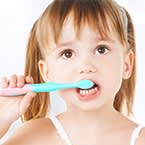KIDS-3-12
Tooth Development: Anatomy of the Mouth and Teeth
The main structures of the mouth include your teeth, which are required for initial digestion, your tongue which is the muscle responsible for taste and sensory perception, your gums which surround the teeth to hold them in place, and your cheeks, which aid with speech and facial expressions.
Stages of Tooth Development
Your child’s teeth begin to form before they’re even born. Here’s what you can expect at each stage of tooth development:
First stage: Teeth begin to develop a lot earlier than most people would expect, with the basic tooth substance forming while still in the womb. This process begins when the fetus is about six weeks old, furthering the importance of maintaining good nutrition while pregnant.
Second stage: While still in the womb, the hard tissue that envelopes the teeth begins to take shape, occurring while the fetus is about three to four months of age.
Third stage: It is at this time where the tooth begins to erupt through the gum line, occurring between six and twelve months after birth. Usually referred to as “teething,” this stage is often uncomfortable and painful but passes quickly. All twenty primary “baby” teeth or “milk” teeth should protrude by thirty-three months.
Fourth stage: At around six years old, the primary teeth begin to fall out. They are soon replaced by thirty-two permanent “adult” teeth. The last primary tooth is usually lost by the age of twelve, with most permanent teeth in place by thirteen. The wisdom teeth come in between the ages of seventeen and twenty-one. However, they are frequently removed by a dentist due to overcrowding or risk of infection, though this varies by individual.
Parts of the Tooth
The four major parts of the tooth are enamel, dentin, pulp, and cementum. Together, these components make up each tooth and are all crucial in ensuring smiles stay healthy and strong.
- Enamel: The outermost layer of the tooth, enamel protects your teeth from decay, erosion, and sensitivity.
- Dentin: The inner layer, dentin makes up most of the composition of the tooth.
- Pulp: Soft tissue inside the tooth, the pulp is responsible for the production of dentin while also housing the nerves.
- Cementum: The element of the tooth that secures it to the jaw, cementum covers the outside of the root directly underneath the gum line.
Keeping Your Kids’ Teeth Healthy
As your child’s teeth develop, be sure they continue to grow good oral hygiene habits:
- Teach them proper oral care practices of brushing twice and flossing once a day from an early age
Learn more on how to brush kids teeth. - Encourage them to continue to care for their smiles through fun toothpaste flavors, toothbrushes featuring their favorite characters, and interactive apps that help them brush longer and more effectively
- Visit the dentist twice a year with their first appointment scheduled right after their first tooth emerges
Learn more about when to take your baby or toddler to the dentist.
Understanding the anatomy and development of young mouths and teeth can help you to better spot the signs of infection, abnormality, and disease before too much damage is done. Maintaining a thorough oral care routine from an early age encourages kids to continue to practice good oral hygiene habits to keep their smiles healthy and strong.
Discover More
 How to Brush Your Teeth for Kids
How to Brush Your Teeth for Kids



